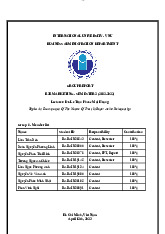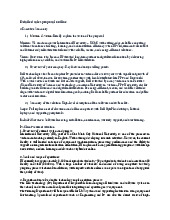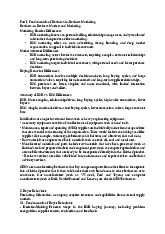



Preview text:
I. Research purposes/questions:
Why do we have to conduct this research?
This study aims to address the significance of confidence in buyer-seller relationships and to
better understand how trust develops in these relationships. The results of this study can help
companies create successful trust-building and trust-maintenance strategies, which can lead
to increased client loyalty and revenue.
What is the difference of this research from others?
This study focuses on the multidimensional character of confidence and how it includes both
cognitive and affective components. This research goes beyond previous studies that have
mainly focused on the role of reputation and past experience in trust formation.
What are the contributions and significance of this research?
The study's results have significant consequences for businesses seeking to establish
confidence with their customers, as well as researchers interested in the nature of trust in buyer-seller interactions.
II. Theoretical background/ foundation:
- Calculatative: Trustor calculates the costs and/or rewards of a target acting in an untrustworthy manner
- Prediction: Trustor develops confidence that target’s behavior can be predicted
- Capability: Trustor assesses the target’s ability to fulfill its promises -
Intentionality: trustor evaluates the target’s motivations. III. Conceptual model What are they?
What are the independents/ dependent variables?
Dependent variables: anticipated future interaction.
Independent variables are the remaining
variables except supplier firm trust,
salesperson trust and purchase choice
because they are mediating variables
which affect the final variable -
anticipated future interaction.
Direction of the relationships in the hypotheses?
Independent variables affect the mediating variables (Supplier firm trust, salesperson trust
and purchase choice) and then these variables affect the dependent variable (Anticipated future interaction). V. Research Method
What are the research methods?
This study employed a quantitative method with Three-wave mailing approach, which
collects data via online survey through email invitation.
Why did the author(s) use this method but not the other?
First off, the sample frame only includes 678 National Association of Purchasing
Management members, making it quite evident that the author will need to work hard to
extract the most fully filled surveys from that frame. And since more than half (55%) of the
completed surveys were returned in response to the last mailing, it is safe to infer that this
strategy was chosen because it increases response rates.
Another point worth considering is that by comparing data from early and late respondents,
this method identified that nonresponse bias was not a serious problem and that there were no
statistically significant differences between early and late respondents.
What are the advantages/ disadvantages of this method?
The Three-wave mailing approach collects information, statements and data of respondents in
one database enabling the researchers to gather all answers at a time. Moreover, all answers
are easily reviewed to change or to replace when moving to another part of the survey.
Meanwhile, sending reminder emails by The Three-wave approach to participants who have
already been invited to the second portion of the questionnaire but have not yet responded is
somewhat complicated. If a participant wants to skip a wave or join later, it could be
challenging in surveys with more than two waves. Additional filters are required in this situation.
VI. What can we learn from the results? In practice? In theory?
In theory, the five trust-building process framework provides a new theoretical insight on
how trust is formed. Second, the research indicates the differences in developing trust for
salespeople and employers. Third, this study offers deeper insights into establishing and
nurturing trustworthy business relationships. Finally, the research suggests that the selling
context could moderate the development and influence of trust. In practice, suppliers should
prioritize managing customers' perceptions and highlight customer satisfaction. For
managers, it is advisable to incorporate the trust-building processes into their salespeople training program.
VII. Do the results support the hypothesis?
The results support the hypothesis that supplier size and willingness to customize positively
impact buying firm trust, and that the trust of the supplier's salesperson has a positive effect
on the trust of the selling firm. Additionally, a salesperson's expertise, likability, and
similarity to members of the buying firm, as well as frequency of business contact with the
salesperson, positively influence the buying firm's trust of the salesperson. The buying firm's
trust of the supplier firm also has a positive effect on its trust of the salesperson, and selected
suppliers and their salespeople are more trusted than those not chosen.


